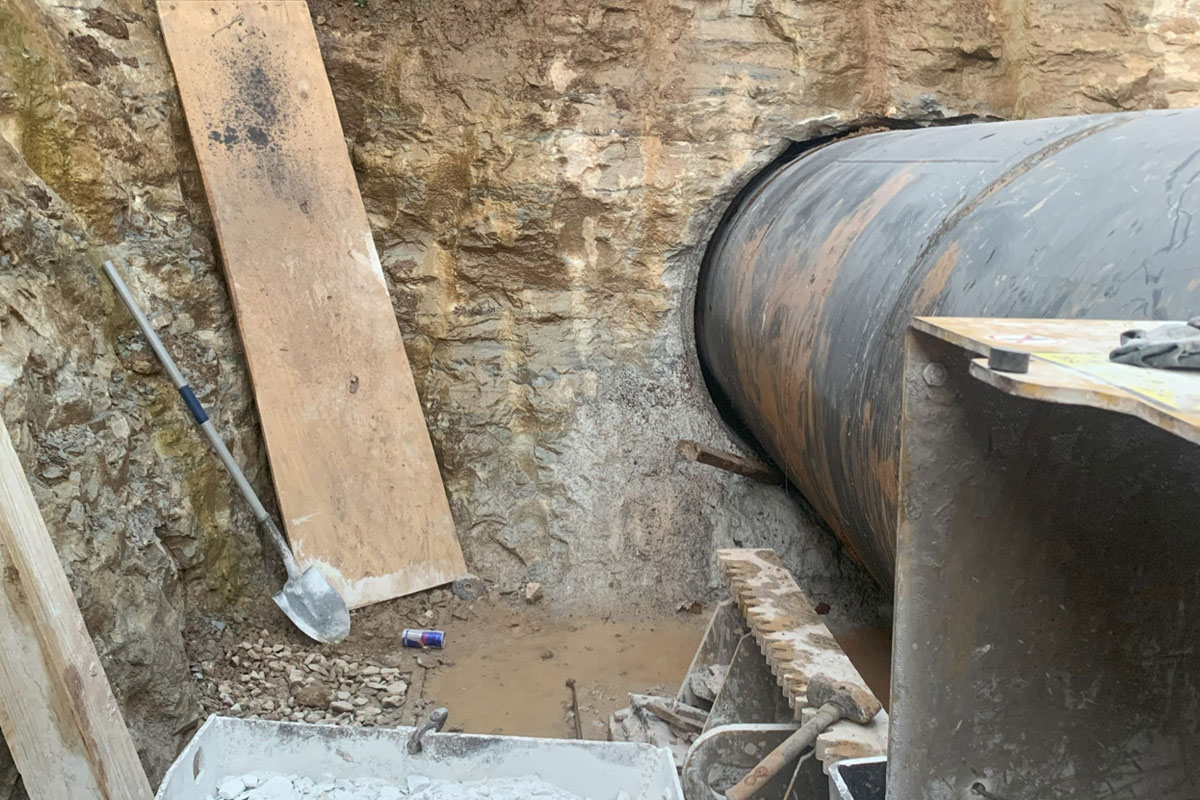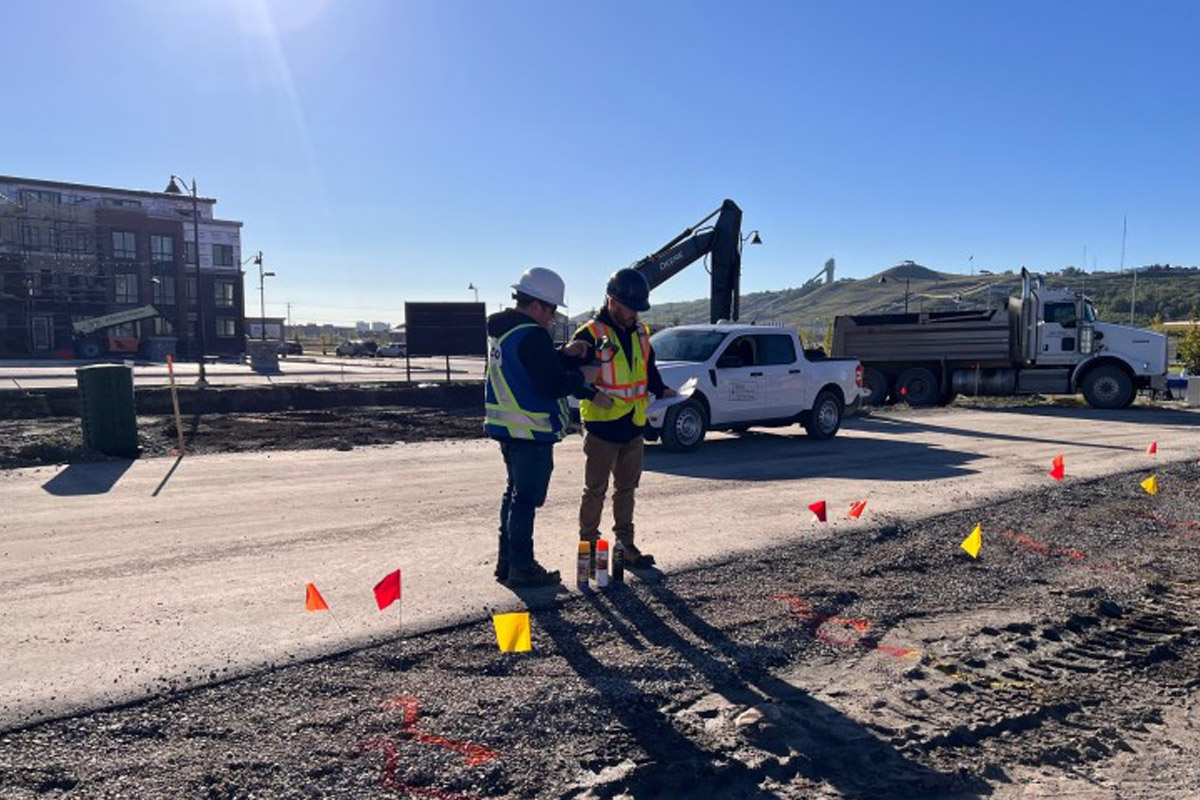
How to Auger Bore in Specific Ground Conditions
Auger boring is an art that takes a significant amount of training and seat time to master. Pacific Boring has more than 40 years of auger boring experience primarily in the Western United States.
Over these years, we’ve done a significant amount of research and development with auger boring and pipejacking. We’ve partnered with other contractors and manufacturers, sharing ideas and techniques to help advance the industry.
The goal of this article is to continue this effort, to provide knowledge to engineers, owners and add value to other contractors who can reference these essential tips when operating in both hard and soft ground conditions.

Auger Boring in Soft Ground
- Lead Casing Preparation
The lead casing should be beveled and flared to provide a cutting edge and overcut. The overcut amount should not exceed that specified by the contract documents, which is typically specified in the 1-in. radial overcut range. If the pipe is a larger diameter (more than 36 in.) a band is typically welded around the leading edge. Bands should also be used in smaller diameters (less than 36 in.) where tough ground conditions are anticipated to reinforce the leading edge. - Auger Placement
If the ground is firm, the cutterhead can be placed slightly outside the leading edge. Too often we see specifications that require the contractor to push a “plug” however, in most cases where the ground is not soft enough or does not exhibit running behavior, and it doesn’t work. The force required to push the casing through this ground can damage the casing or simply “stick” the casing stopping forward progress altogether.
Running ground behavior, such as clean sands, would justify retracting the cutterhead inside the casing. This is typically accomplished by welding a 2-ft long piece of casing on without adding any auger. This will retract the auger 2 ft inside the casing. If necessary, the cutterhead can also be removed, increasing the distance from the leading edge to the point of excavation.
Very stiff to hard soils requires the cutterhead to be in front of the casing’s leading edge. Wing cutters on the bit must cut slightly larger than the overcut band. If not, the casing will begin to egg if the band cannot cut the ground. - Groundwater Control
Auger boring should not be used below the groundwater table in sands or silts where the ground would exhibit flowing behavior. This type of ground requires dewatering of the alignment. Where the alignment cannot be dewatered, another method should be selected such as mircotunneling. Auger boring can be performed around the groundwater table in clays that have a low permeability. In these ground conditions you should anticipate some water reaching the pits and plan to sump out the pit. - Machine & Cutterhead Selection
The proper machine should be selected for the work. The ground type, diameter and length should all be taken into consideration. The machine should have enough thrust to advance the casing through the ground and enough torque to turn the augers.
There is a wide variety of cutterheads offered by several different manufacturers. Standard dirt bits are used in soft ground. Wing cutters are required in harder soil types or where large gravel and cobble may be present. If there is a significant amount of cobble or boulders, hand-mining/removal is required. - Casing Diameter
The casing size should not only be sized according to the carrier pipe size and to account for installation tolerances, but also for the anticipated ground conditions. For example, as mentioned above, if cobbles or boulders are anticipated, the casing should be sized to allow for man entry for removal and handling of the material.

Auger Boring in Rock
- Lead Casing Preparation
The lead casing should be reinforced banded with a hand approximately 3 to 4 in. long. The overcut amount should not exceed that specified by the contract documents which is typically specified in the 1-in. radial overcut range. The amount of overcut isn’t as concerning in rock since there is little risk of surface settlement. The band should not be sized larger than the overcut of the bit, but not so much smaller that it will not bring in fines from the cutterhead excavation. The lead casing is shortened so the cutterhead is in front. - Auger Placement
In rock, the augers should be all the way forward, placing the cutterhead outside the leading edge of the casing. Augers cannot be retracted for two reasons. First, the casing alone will not penetrate the rock without first being excavated. Second, the bit’s overcut flippers will not open if it is inside the casing. - Groundwater Control
Ground water in rock is generally not an issue for auger boring projects. The crossings are relatively shallow, rock is not highly permeable, and there is no risk of the water changing the ground behavior. If the rock is fractured and contains water, the Engineer’s design should have systems in place to properly deal with the water. - Machine & Cutterhead Selection
The proper machine should be selected for the work. The rock strength, diameter and length should all be taken into consideration. The machine should have enough thrust to advance the cutterhead and casing through the ground and enough torque to turn the augers and cutterhead.
There is a wide variety of cutterheads offered by several different manufacturers. We use flat and “Christmas tree” style cutterheads. Both style of cutterheads have replaceable carbide tip bits. The Christmas tree style bits can cut through higher strength material, but the rule of thumb is not higher than 6,000-psi unconfined compressive strength. Higher strength rock would require a disc cutterhead like the Robbins SBU.
More recent innovations include Down the Hole Hammers (DTH), like what is offered by Geonex. I visited the first Geonex casing installation in the United States in 2019 in Wisconsin and was impressed with the machine’s ability to excavate in rock. It is important that rock strength is provided prior to bid so that proper the proper cutterhead selection is utilized on the project. - Casing Diameter
Like soft ground, the casing should be sized appropriately for the carrier pipe and to account for installation tolerances. The casing diameter will also be driven by the rock strength and equipment availability. For example, the job may call for 36-in. casing in 14,000-psi rock. However, the contractor may upsize to 48-in. casing if they have a 48-in. Robbins SBU available.

As most readers know, auger boring is hard, which is probably an understatement. It’s never as easy as just checking the boxes because each crossing presents its own challenges and takes on a life of its own. It takes good amount of research, planning and engineering to make a project successful. It is important that engineers design projects with realistic tolerances in mind and specify the appropriate method for the anticipated ground conditions.




